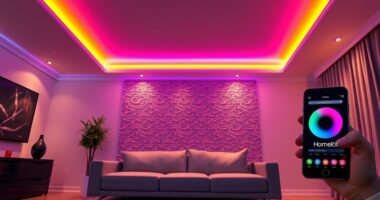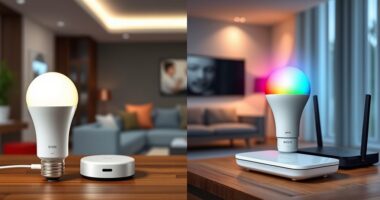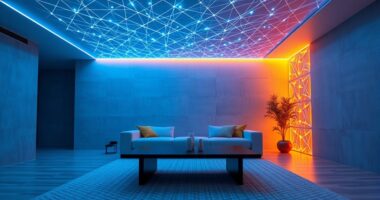Implementing circadian lighting in your workspace helps regulate your internal clock by mimicking natural daylight changes, which boosts alertness and reduces fatigue. As the light shifts from warm to cool tones throughout the day, your body stays aligned with natural rhythms, improving focus and productivity. Bright, well-calibrated lighting stimulates your visual and cognitive systems, keeping you alert and comfortable. Continuing to explore this topic reveals how you can optimize your environment for maximum work performance.
Key Takeaways
- Mimics natural daylight patterns to regulate employees’ internal clocks, enhancing alertness and overall productivity.
- Adjusts light spectrum and intensity to boost focus during peak work hours and promote relaxation during breaks.
- Supports circadian hormone balance, reducing fatigue and improving concentration throughout the workday.
- Smart lighting systems adapt in real-time to natural light, maintaining optimal working conditions and energy efficiency.
- Improved circadian alignment leads to better sleep quality, resulting in increased daytime performance and workplace well-being.
Understanding Circadian Rhythms and Their Impact on Work Performance

Understanding circadian rhythms is essential because they regulate your body’s internal clock, influencing alertness, sleep, and overall performance throughout the day. Your sleep cycles are closely tied to these rhythms, dictating when you feel sleepy or awake. During the night, your body releases hormones like melatonin to promote sleep, while cortisol levels peak in the morning to boost alertness. Disruptions to these rhythms can cause fatigue, decreased concentration, and reduced productivity. When your internal clock is aligned with natural light patterns, hormone regulation supports restful sleep and sharp waking hours. Recognizing how these processes work helps you optimize your environment and routines to stay alert during the day and sleep well at night, maximizing your work performance and overall well-being.
How Circadian Lighting Mimics Natural Daylight to Support Well-Being

Circadian lighting systems are designed to replicate the natural changes in daylight throughout the day, helping your body stay aligned with its internal clock. They adjust the color temperature and light spectrum to match outdoor conditions, from warm, amber tones in the evening to bright, bluish light in the morning. This mimics the way natural sunlight varies, supporting your overall well-being. By shifting the color temperature throughout the day, circadian lighting promotes alertness when needed and encourages relaxation as evening approaches. The light spectrum is carefully calibrated to guarantee your environment feels natural, reducing stress and enhancing mood. This seamless replication of daylight helps you stay energized, focused, and healthy, ultimately boosting your productivity and quality of life at work. Proper light spectrum calibration is essential to ensure the lighting environment effectively supports circadian rhythms and overall health.
The Science Behind Increased Focus and Reduced Fatigue With Circadian Lighting

When your workspace is illuminated with lighting that closely mimics natural daylight, your brain receives signals that help regulate your internal clock, leading to increased focus and less fatigue. The key factors are color temperature and light intensity. Cooler color temperatures, similar to midday sunlight, boost alertness by signaling your brain to stay active. Bright light intensity further enhances this effect by stimulating your visual system and improving concentration. Additionally, light quality plays a crucial role in creating an environment conducive to sustained attention and comfort. Together, optimal color temperature and appropriate light intensity synchronize your alertness levels with natural rhythms, reducing mental fatigue. This science-backed approach keeps you focused longer and prevents energy dips. By aligning indoor lighting with your body’s natural cues, you experience sharper focus and sustained productivity throughout your workday.
Implementing Circadian Lighting: Practical Steps for Modern Workspaces

To effectively incorporate circadian lighting into your workspace, start by evaluating the existing lighting setup and identifying areas where natural light is limited. Next, install lighting sensors to monitor ambient light levels and adjust artificial lighting accordingly. This ensures consistent circadian cues throughout the day. Additionally, understanding the legal aspects of workplace modifications can help ensure compliance with safety and building codes. Then, focus on employee training—educate staff on how to use adjustable lighting controls and the benefits of circadian lighting. Consider implementing task lights with tunable features for individual needs. By combining sensor technology with proper training, you create an environment that aligns lighting patterns with natural rhythms. These steps help optimize productivity, reduce fatigue, and enhance overall well-being in your modern workspace.
Future Trends: The Evolution of Lighting Technology and Employee Productivity

As technology advances, lighting systems are becoming smarter and more responsive, shaping the future of workplace productivity. Smart sensors play a vital role by automatically adjusting lighting based on occupancy, natural light levels, and circadian needs. This responsiveness guarantees ideal lighting conditions throughout the day, boosting focus and reducing fatigue. Additionally, new innovations prioritize energy efficiency, allowing you to save costs while maintaining high-quality lighting. You’ll see more integration of IoT-enabled systems that communicate seamlessly with other building technologies, creating personalized lighting environments. These advancements not only enhance employee well-being but also promote sustainable practices. Moreover, understanding juice detox and its effects can contribute to overall health, further supporting a productive workplace. As these smart, energy-efficient systems become more widespread, your workspace will evolve into a more dynamic, health-conscious, and productive environment.
Frequently Asked Questions
Can Circadian Lighting Be Customized for Individual Employee Preferences?
You can absolutely customize circadian lighting to suit individual employee preferences. Personalized lighting systems allow you to adjust brightness and color temperature, ensuring ideal employee comfort. By tailoring lighting to each person’s needs, you boost focus and well-being. This customization creates a more inclusive, supportive environment where everyone feels comfortable, ultimately enhancing overall productivity and satisfaction. Embracing personalized lighting shows your commitment to employee health and happiness.
What Are the Initial Costs Versus Long-Term Savings of Implementing Circadian Lighting?
At first, installation costs for circadian lighting might seem high, but don’t overlook the energy savings you’ll enjoy long-term. While the initial investment covers advanced fixtures and setup, these lights reduce energy consumption and maintenance over time. This juxtaposition shows that, although you pay more upfront, the savings on energy bills and improved employee well-being make it a smart, cost-effective choice for your workplace.
How Does Circadian Lighting Affect Employees With Specific Health Conditions?
You might wonder how circadian lighting impacts employees with health conditions. It offers significant health implications by reducing fatigue and improving mood. Lighting customization guarantees each employee’s needs are met, especially those with light sensitivities or sleep disorders. By adjusting the intensity and timing, you create a healthier environment, helping employees manage their conditions better and boosting overall well-being and productivity in your workplace.
Are There Any Potential Side Effects of Circadian Lighting Exposure?
Did you know that over 20% of people report increased light sensitivity? When you’re exposed to circadian lighting, it can sometimes cause side effects like headaches or eye strain, especially if you’re sensitive to light. It’s important to avoid circadian disruption by adjusting lighting to suit your needs. If you notice discomfort, you should consult a professional to prevent potential negative effects on your health and well-being.
How Can Businesses Measure the ROI of Circadian Lighting Investments?
You can measure the ROI of circadian lighting investments by tracking productivity metrics like employee output and focus, alongside energy savings over time. Implement surveys to gather feedback on well-being and alertness. Comparing pre- and post-installation data helps you evaluate improvements. Monitoring these factors provides a clear picture of how circadian lighting boosts efficiency and reduces costs, demonstrating its value to your business.
Conclusion
By embracing circadian lighting, you can transform your workspace into a powerhouse of productivity and well-being. Imagine your environment as a radiant sun that energizes your mind and keeps fatigue at bay—it’s like revealing a secret superpower. When you align your lighting with your natural rhythms, you’ll notice sharper focus, boosted creativity, and a workday that feels half as long. Don’t just work—thrive under lighting that supercharges your potential.









